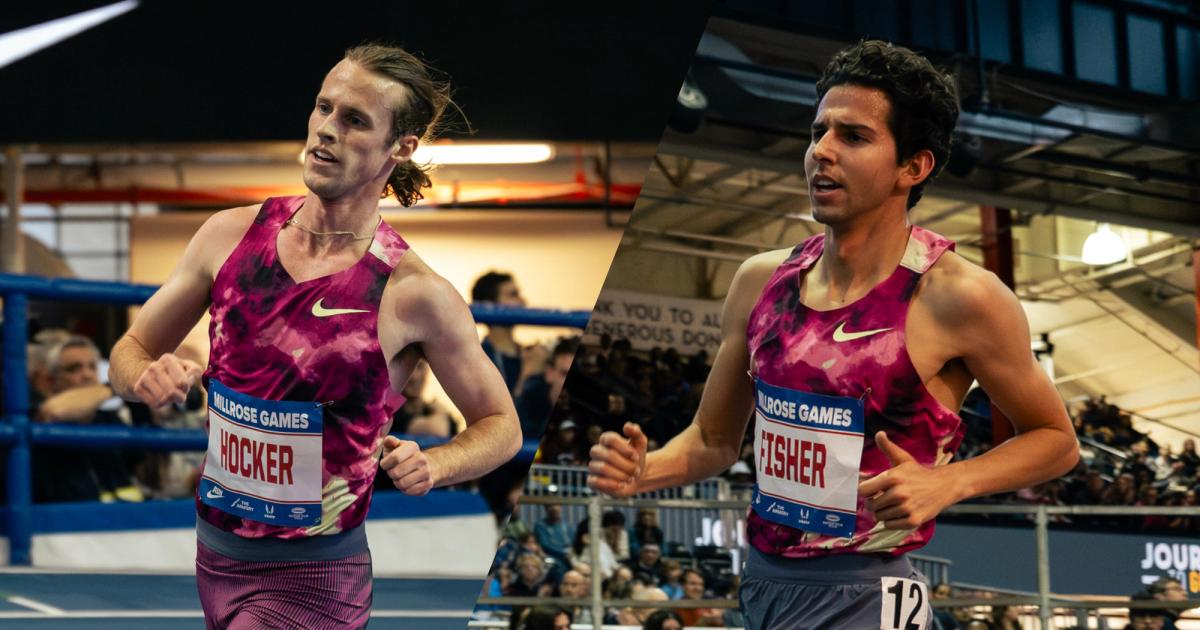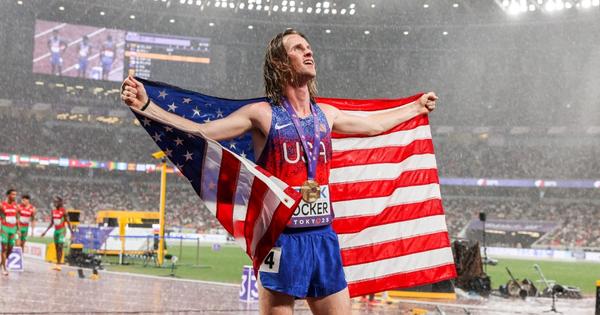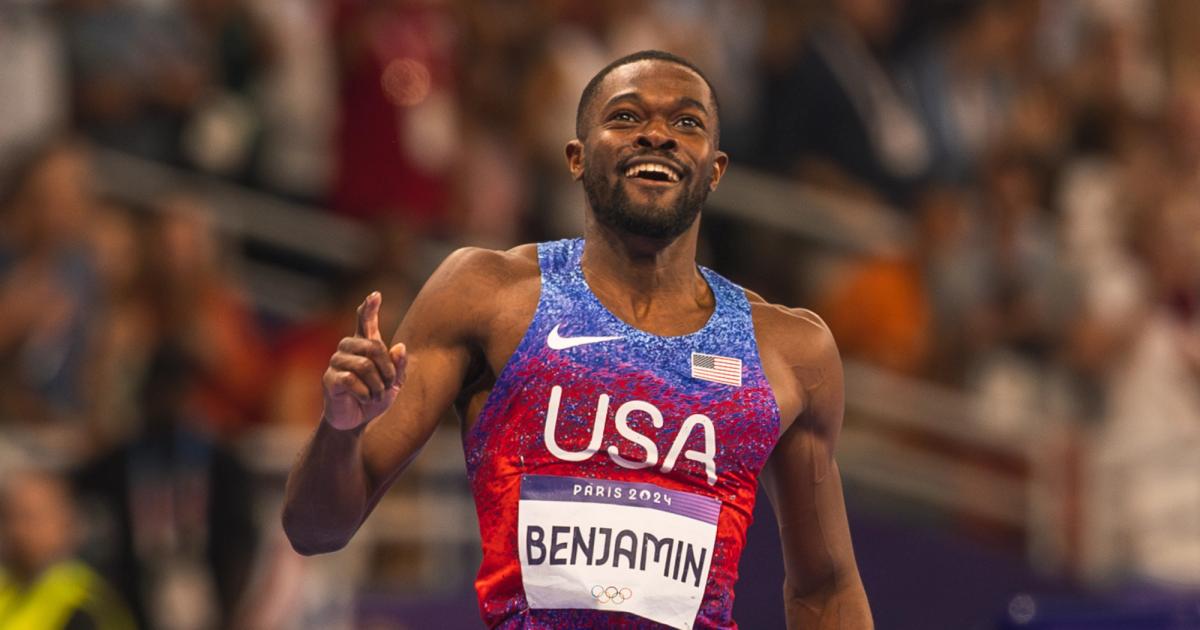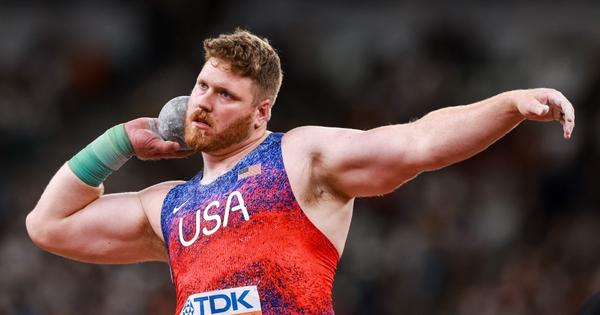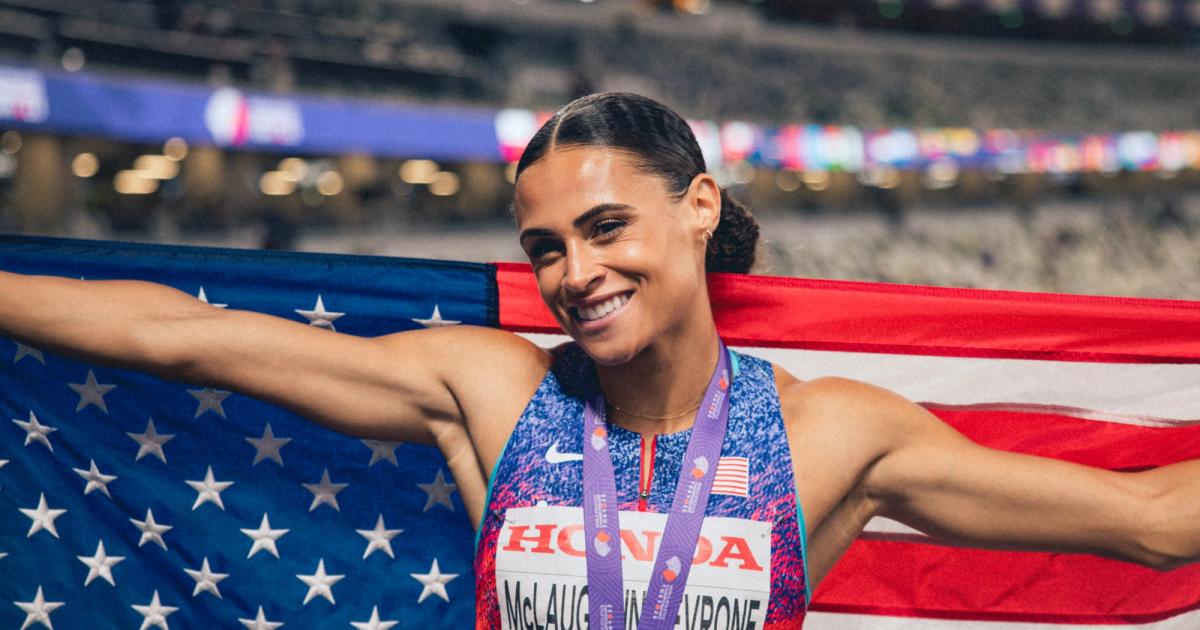By Chris Chavez
November 19, 2025
Double Olympic bronze medalist Grant Fisher and 1500m Olympic champion and 5000m World champion Cole Hocker will renew their rivalry for a rematch in the two-mile at the Millrose Games on February 1st, 2026 at the Armory Track and Field Center in New York City.
The Millrose Games are the second stop in the World Athletics Indoor Tour Gold calendar.
“Millrose is the place to be,” Hocker says. “The performances match the atmosphere, and anytime something’s in New York, it’s going to be special. The crowd feels like it’s right on top of the track, which is great for racing. And the stadium setup just creates this amazing energy. Highly recommend going if you haven’t.”
Last year’s 3000m duel between the two was arguably one of the greatest races in U.S. history. The two American greats took advantage of near-flawless pacing through 1800m before Fisher took control of the race and laid down back-to-back sub-30-second laps (29.82-29.81) but Hocker refused to break. With three laps remaining in the race, Hocker boldly swung to the lead and pushed with a 29.08 and then a 28.86, but Fisher stayed on him. The bell lap produced one of the most memorable finishes of the 2025 indoor track season as Fisher clawed back on the last bend and crossed the finish line first in 7:22.91 for a new world record. Hocker followed in 7:23.14. Both men were under Lamecha Girma’s previous world record of 7:23.81.
It was a perfect snapshot of why the Millrose Games endures as one of the best meets in the world.
“You’re guaranteed electric performances and most years you get several historic ones,” Fisher says. “It’s my favorite indoor meet: intimate, loud, historic building…. The atmosphere is unreal. Everyone shows up ready for a battle.”
At the 2024 edition of the meet, two-time 1500m Olympic medalist Josh Kerr shattered countryman Mo Farah’s two-mile world record with a 8:00.67 victory. Fisher finished him in 8:03.62 for the third-fastest time in history and the American record. Hocker is No. 6 all-time with his 8:05.70 personal best.
The full field will be announced at a later date.
Tickets to the 118th Millrose Games are on sale now at MillroseGames.org
We spoke with Hocker and Fisher about the upcoming matchup. The following interview has been edited lightly for clarity.
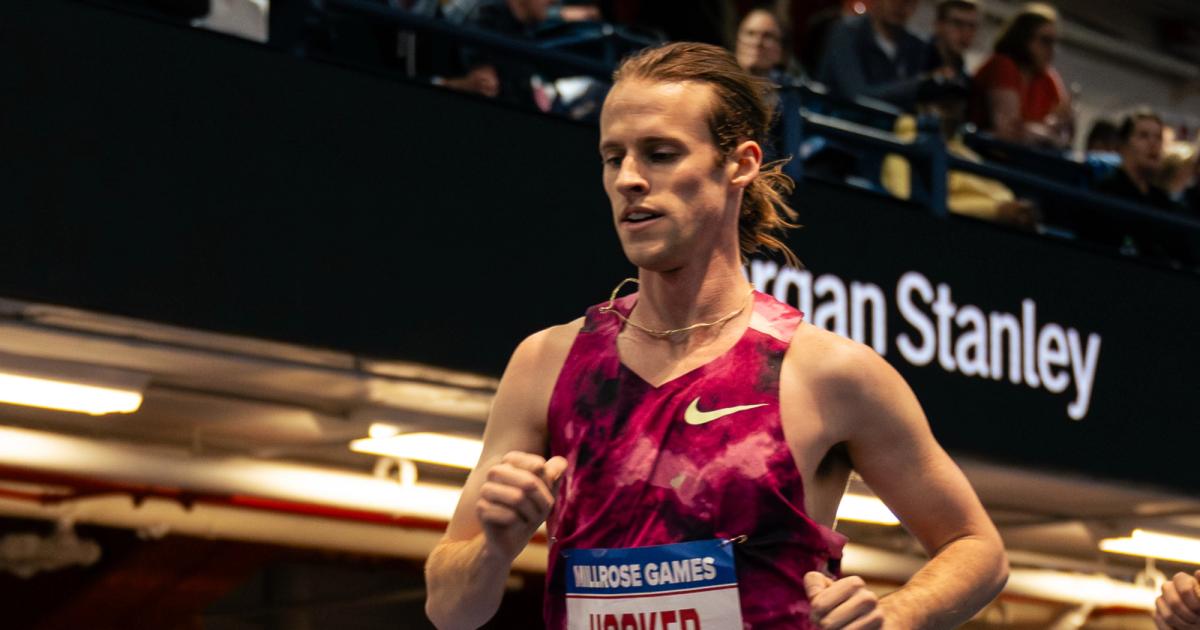
Johnny Zhang
Cole Hocker on Millrose, Rivalries and Leveling Up for 2026
CITIUS MAG: It feels like it’s been less than two months since we last talked to recap Tokyo, and now we’re already pivoting to the indoor season. You’re running the two-mile at the 2026 Millrose Games. What went into choosing that event this time around?
Cole Hocker: Track never stops—especially in what people call an “off year,” which doesn’t really exist anymore. Honestly, I think people race more in these years. I’m excited for the two-mile because last year’s race with Grant was, in my biased opinion, a race for the ages. I don’t see why this year’s version would be any different.
What we ran last year over 3000m is basically equivalent to what the two-mile record is now. So it’s essentially the same race. The two-mile makes sense for where I’m at in my season, and it’s become a really good event for me—especially indoors.
CITIUS MAG: Last year’s matchup at Millrose was such an epic clash. What makes Grant such a good opponent?
Hocker: Going into that race, my plan was to stick on whoever was leading and try to win. I had a feeling it would be Grant, but you never know until the race unfolds. I thought the American record was within reach.
When I made that move with about three laps to go—that was uncharacteristic for me. But I felt good, and I trusted it. Grant is such a good opponent because I know where his head is at, and he knows where mine is. In that race, he was going to hammer it and go for the record. He knew he had to run away from me, and I knew I couldn’t let him go. Our strategies differ, but when they collide, it makes for a great matchup.
CITIUS MAG: After that Millrose race, you said it gave you confidence to take the lead early—even though Grant got you at the end. Now that we have the full 2025 season to reflect on, how valuable was that moment?
Hocker: It definitely came back to me later in the season. I didn’t plan on going early that day, but I told myself that if I wanted to grow as an athlete, I had to try something new. I’d taken the lead in races before, but never at that pace.
Coming off the Olympic gold, I knew the race was going to hurt no matter what, so I figured this was a way to push what I thought was possible. And it paid off. A race like the US 5000m wasn’t fast, but I went to the front and led for about 11 laps—and that strategy worked. So yeah, Millrose played a part in that for sure.
CITIUS MAG: After Millrose in 2024, you said you were already better than the year before. Then you went on to win Olympic gold. So looking ahead—how does 2026 Cole compare to the 2024 version who ran 8:03 in that world-record race?
Hocker: I’m definitely a different athlete. In that 2024 race, I was just hanging on. Last year, I was truly competing. The times Grant and I ran were probably the fastest possible that day.
I have sheer confidence in my training. Year after year, I’ve become better—mentally and physically. I feel like a real testament to “trust the process,” as cliché as that sounds. The championships and big meets like Millrose have gone well the past few years, and each year I feel more dialed in.
CITIUS MAG: Have you and Coach Ben Thomas already mapped out the indoor season?
Hocker: Loosely, yeah. The plan is Millrose, USAs, and maybe a mile at JDL—they’ve got a new track; I think it’s not flat anymore. Then the goal is World Indoors.
CITIUS MAG: Last year, you skipped USAs and Worlds Indoors because of the Grand Slam early season. Is this year just more open?
Hocker: Exactly. Last year was uncharted territory since no one had done that Grand Slam circuit before, so we were learning as we went, and I wanted to commit fully to it. Plus, there was a true world championship at the end of that calendar. This year, World Indoors is a global title. Two events could be in play. So it would feel strange not to go for that.
CITIUS MAG: So 1500/3K indoors, and then the World Ultimate double outdoors?
Hocker: Yep. Worked out nicely. I’m hyped.
CITIUS MAG: Why no U.S. cross country? You broke some hearts with the decision to skip out.
Hocker: I know, I’m sorry. It came down to how I wanted to set up my season. You can’t do everything, even if I want to. It’s awesome that it’s in the U.S., but the turnaround from Tokyo didn’t make sense for me.
I’m not going to run a U.S. championship if I’m not ready—I’m not showing up for a workout. I would’ve needed to get really fit really fast, and that’s a recipe for injury. And the indoor season is important this year, with a global medal at stake.
Plus, I feel like the 5K is already long… the 10K is still a stretch. Competing well at that would’ve required a long base phase that I just didn’t have time for.
CITIUS MAG: The two-mile world record is 8:00.67. What’s more important this time—the win or the record? Or does it naturally come if you and Grant fight again?
Hocker: I think the time will come if the race plays out aggressively, but I also want to make sure we’re actually going after it. Last year, Grant carried the race to the American record pace. When I went around him, we got into world-record territory.
I want to chase the record—that’s on my to-do list. It’s within reach. Regardless of how others want to race, I’m going for it. And I’m sure Grant—and maybe others—are thinking the same.
CITIUS MAG: You still don’t have one, right?
Hocker: Yeah, I still don’t have a world record. It’s pathetic. (laughs)
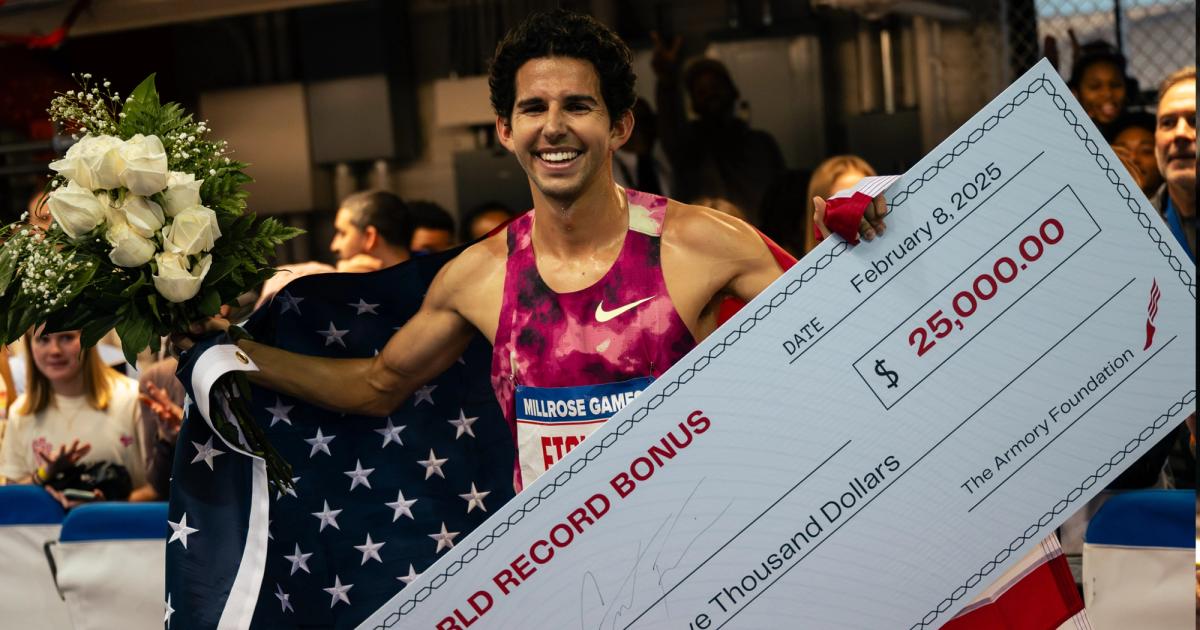
Johnny Zhang
Q&A: Grant Fisher on Millrose, Off-Year Experiments, and His Road-Curious Future
CITIUS MAG: The big announcement coming Wednesday: the rematch is on. You vs. Cole in the two-mile. What led you to choose that event?
Fisher: I was thinking about this this morning. Millrose kind of alternates every year: 3000m, two-mile, 3000m, two-mile. Last year, we had that great battle over 3000m, and it felt a little repetitive to run the exact same race again.
The two-mile is basically the same event, but it’s run less often. You have different national records in play, there’s no long list of PRs to compare to, and it’s just fun. Millrose has always treated me well. I’ve had good results there. The environment is electric. So it felt like the right move.
CITIUS MAG: With Cole choosing the two-mile over the Wanamaker, you two are lining up again. What makes him such a good opponent?
Fisher: Indoors – both in the Wanamaker Mile and the two-mile – gives you dynamic matchups. Last year was fun because Cole is known more as a 1500m–5,000m guy, and I’m more of a 5000m–10,000m guy. So the 3000m was this perfect middle ground. The two-mile will be similar.
At Millrose, you get matchups that you’d never see before a championship. You get people stepping out of their comfort zones because they want to race and have fun. Last year felt like that—two guys from different specialties meeting in the middle and making something special.
CITIUS MAG: What do you think 7:23 for 3000m converts to for two miles?
Fisher: I’m honestly not sure, but maybe 7:58 high?
CITIUS MAG: That conversion puts you right in world-record range. Feels like an obvious question: What matters more—time or the win? Last year, Cole took the lead with 600m to go and pushed you two into world-record territory. I spoke to Cole earlier and he’s definitely thinking world record. But it still feels like the time is just a byproduct of the two of you racing.
Fisher: Exactly. It’s incredibly hard to chase a record alone. Once the pacer steps off at a mile or 2K, you’re on your own. Having someone on your shoulder makes a massive difference. Last year, we had lead changes, which helped the pace.
But neither of us was thinking, 'The record is slipping—we have to save it,' as we headed to the front. It was purely racing to win. That’s the key. If you focus on the time, it often slips away. But if you focus on racing, and you’re in the right field on the right track, the time comes. And Ray (Flynn) and the meet directors are clearly setting it up to be fast.
CITIUS MAG: Now that we can look back on the full 2025 season, what did last year’s 3000m at Millrose do for your year? What did you learn?
Fisher: It was a huge confidence boost to start the year. I’d worked on my kick, and felt like I’d improved enough to be there with Cole late in the race.
My early outdoor races were in Grand Slam, and they all came down to the kick. I felt more confident because of Millrose. By September, I was tired from focusing on kicking all year, but you live and learn. This year, we’re taking a more sensible approach.
Indoors is usually the setup for outdoors, but this is an off year. So, I think you’ll see pros trying new things—maybe racing odd distances, like a 2K or hopping into road races. It’s a fun year to get creative.
CITIUS MAG: How did your fitness going into Tokyo compare to where you were, in world record shape indoors?
Fisher: It’s hard to compare. Time-trial fitness and championship fitness are different beasts. Indoors, my engine was running hot—able to hold a super high pace. The race with Cole wasn’t closed in crazy-fast splits; we were basically going from the gun.
By the end of outdoors, I was more fatigued. That taught me I need to map out priorities better, take breaks at the right time, and time my peaks smarter.
This year is exciting because it feels like a free year. No championship dictating everything. For a lot of pros, it’s the first true off-year of their careers.
CITIUS MAG: Your coach said no cross country this year. Why?
Fisher: I wanted to run U.S. Cross, but I ended the season with an injury. I thought I fixed it during my break, but it didn’t fully resolve. I only started workouts again last week—that gave me three weeks until U.S. Cross. Pushing that hard, that fast after an injury didn’t seem worth the risk. I wasn’t able to run pain-free for quite a while, which is why I was biking a ton. I feel good now, but I don’t want to rush and blow it up again.
CITIUS MAG: What was the injury?
Fisher: An issue with my pubic symphysis—the joint at the front of the pelvis. I’d never heard of it until I injured it. It got really inflamed, and the surrounding muscles were angry too. Oddly, racing felt better than resting. But now was the time to finally fix it.
CITIUS MAG: What were your assessment on Tokyo? Does it feel like the 5000m and 10,000m feel more chaotic than ever and more up to luck, where going fast from the gun is risky, and leaving it to a kick means anyone can win?
Fisher: The depth gets stronger every year. One person retires, five more take their place. It makes the races unpredictable in a good way.
In the 10K, I felt good until I tried to kick. I was flat. In the 5K, my best shot felt like pushing the pace early because I didn’t feel sharp enough for a big kick. But I squeezed too hard, too early, and ended up being the one most fatigued at the end.
Not my proudest Worlds. I was in the races, but not truly in the fight at the end. But it’s something to learn from. And yeah—gone are the days where three guys break away and you know the podium with three laps to go.
CITIUS MAG: If I give you a magic wand and you get one do-over in each final. What would you change?
Fisher: In the 5K, I’d wait longer before going to the front. Same plan, just delayed. In the 10K, I’d conserve more—less back and forth, less policing the front, more sitting. When it was time to kick, I had nothing.
CITIUS MAG: Your coach hinted we might see you in an event you’ve never done. You’ve raced everything from 800m through 10,000m on the track. So are we talking steeple or a half marathon? Give us the percentage chance of doing either.
Fisher: I’ve always wanted to try the steeple, but I’ve basically always been told I’m too short.
So the half marathon is more likely. "I haven't quite decided definitively if that's going to happen or not, but it's something I have my eye on because I'd like to try my hand at the roads at some point. I don't want to wait until my track career is completely over to then crawl onto the roads and see what happens. I'd like to give it a good go when I do end up on the roads, so it's on my mind. I think the next month or two will give insight into when and where I'll feel ready for that. But it's on the table for sure.
In a year where there's a world championship, the half is a little too daunting and too much of a departure from your main goal. I think this is the perfect year to try and see what I can do.
CITIUS MAG: If I’m just speculating aloud. That probably rules out Houston—it’s too soon before Millrose. Something like NYC Half seems more realistic. And you know the instant you step on the roads, you get thrown into the record conversation.
Fisher: Houston is lightning fast. NYC is iconic, though slower. Courses matter a lot—weather, pacing, layout. It’s very different from the track where every track is 400 meters. I have a lot to learn....Even if I run a half this spring and it goes incredibly well, I don't think I'll abandon the track and move to the roads. I think you're seeing more and more people use half marathons and 10K/5K training interchangeably. I don't think they're too different that you'd have to change a ton. Now, the full marathon is completely different...It's completely new territory for me. I'd definitely go in with respect for the distance but I'd also want to put my best foot forward and really go for it, if I end up doing it."
CITIUS MAG: It’s interesting watching someone like Conner Mantz keep a foot on the track while excelling on the roads. It feels like the days are gone when you only move to the roads once your track days are starting to fade.
Fisher: Yeah, Conner has really led the charge. In countries like Kenya, Ethiopia, or Japan, athletes go to the roads much earlier. In the U.S., people used to wait until their early 30s. That limited the ceiling. If you start earlier—like Casey Clinger or Charles Hicks—you get more time to develop. I don’t want to be 35 starting from scratch. I want to explore the roads while I’m still physically strong.
CITIUS MAG: The LA28 schedule came out last week. The 5K–10K double is possible, the 10K–marathon double is possible. What were your early thoughts and reactions to it?
Fisher: I’ve always liked the idea of doubling—more chances in a sport where your biggest race happens once a year, if that. Whether it’s 5K–10K or something wilder like 10K–marathon, the next two years will dictate my direction. If I debut in the half soon, that’ll influence how aggressively I shift toward the roads. Careers don’t last forever—usually your body decides before you do. So I want to make the most of the years when I’m healthy and excited.
By The Numbers
– Grant Fisher owns a 4–3 career head-to-head edge over Cole Hocker: 2–2 vs. Hocker over 5000m; 1–0 vs. Hocker over two miles; 1–0 over Hocker over 3000m; 0-1 vs. Hocker over the mile
– Hocker has won their last three head-to-head races, including the 5000m finals at the U.S. Outdoor Track and Field Championships and the World Championships in Tokyo.
– Fisher is No. 3 all-time in the indoor two-mile with his 8:03.62 from the 2024 Millrose Games.
– Hocker is No. 6 all-time in the indoor two-mile with his 8:05.70 from the 2024 Millrose Games.
– No American has held the two-mile indoor world record since Doug Padilla ran 8:15.02 at The Forum in Inglewood in February 1990.
– Josh Kerr’s two mile world record pace is 29.87 per 200m. Kerr hit the mile in 4:03.63 and then negative-split the second half with a 3:57.04 for the last mile.
– Kerr closed his two-mile world record with a 27.79 final lap. The final lap of Fisher’s 3000m world record was 27.50.

Chris Chavez
Chris Chavez launched CITIUS MAG in 2016 as a passion project while working full-time for Sports Illustrated. He covered the 2016 Olympics in Rio de Janeiro and grew his humble blog into a multi-pronged media company. He completed all six World Marathon Majors and on Feb. 15th, 2025 finally broke five minutes for the mile.
